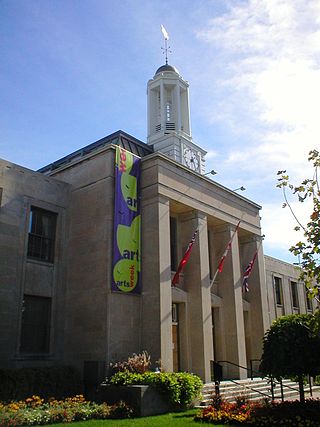
Peterborough is a city on the Otonabee River in Ontario, Canada, about 125 kilometres northeast of Toronto. According to the 2021 Census, the population of the City of Peterborough was 83,651. The population of the Peterborough Census Metropolitan Area (CMA), which includes the surrounding Townships of Selwyn, Cavan Monaghan, Otonabee-South Monaghan, and Douro-Dummer, was 128,624 in 2021. In 2021, Peterborough ranked 32nd among the country's 41 census metropolitan areas according to the CMA in Canada. The current mayor of Peterborough is Jeff Leal.
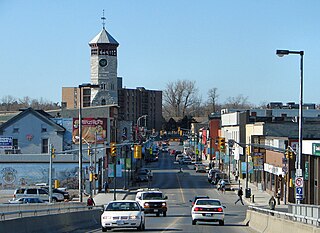
Trenton is a large community in Central Ontario in the municipality of Quinte West, Ontario, Canada. Located on the Bay of Quinte, it is the starting point for the Trent-Severn Waterway, which continues northwest to Peterborough and eventually Port Severn on Georgian Bay.

Canada has a large domestic and foreign tourism industry. The second largest country in the world, Canada's wide geographical variety is a significant tourist attractor. Much of the country's tourism is centred in the following regions: Toronto, Montreal, Quebec City, Vancouver/Whistler, Niagara Falls, Vancouver Island, Canadian Rockies, British Columbia's Okanagan Valley, Churchill, Manitoba and the National Capital Region of Ottawa-Gatineau. The large cities are known for their culture, diversity, as well as the many national parks and historic sites.

Peterborough County is a county and census division located in Southern Ontario, Canada. The county seat is The City of Peterborough, which is independent of the county.

The City of Kawartha Lakes is a unitary municipality in Central Ontario, Canada. It is a municipality legally structured as a single-tier city; however, Kawartha Lakes is the size of a typical Ontario county and is mostly rural. It is the second largest single-tier municipality in Ontario by land area.
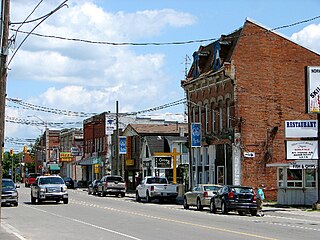
Asphodel–Norwood is a lower tier township municipality in Peterborough County in Central Ontario, Canada, with a 2021 population of 4,658. The land on which the township is situated is the traditional territory of the Mississauga, and became open to European colonization following its survey in 1820. The site that would become Norwood was settled in 1823, and it was incorporated as a village in 1878. The township, in its current form, was created in 1998 by the reunification of the village of Norwood with the surrounding township of Asphodel.
The Peel Art Gallery, Museum and Archives (PAMA) is a museum, art gallery, and archives for the Regional Municipality of Peel and are located in Brampton, Ontario, Canada. Previously, it was the Peel Heritage Complex. Its facilities were originally the Peel County Courthouse, Brampton Jail, a land registry office, and a county administration building. It is opposite Gage Park and Brampton City Hall.
Fleming College, also known as Sir Sandford Fleming College, is an Ontario College of Applied Arts and Technology located in Peterborough, Ontario, Canada partnered with Trebas Institute Ontario Inc.
Eberhard Heinrich Zeidler, was a German-Canadian architect. He designed iconic structures and landmarks in Canada and internationally, most notably in Toronto. These included Ontario Place, the Toronto Eaton Centre and the North York Performing Arts Centre, as well as redevelopments of Queen's Quay Terminal and the Gladstone Hotel. His firm also designed Canada Place in Vancouver for Expo 86.

Raymond Junichi Moriyama was a Canadian architect.
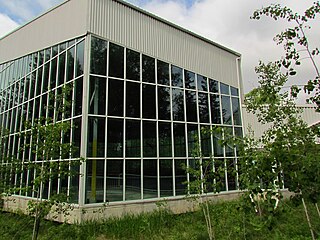
Petroglyphs Provincial Park is a historical-class provincial park situated in Woodview, Ontario, Canada, northeast of Peterborough. It has the largest collection of ancient First Nations petroglyphs in Ontario. The carvings were created in the pre-Columbian era and represents aspects of First Nations spirituality, including images of shamans, animals, reptiles, and, possibly, the Great Spirit itself.

The Canadian Canoe Museum, located in Peterborough, Ontario, Canada, is a museum dedicated to canoes. The museum's mission is to preserve and share the culture and history of the canoe's enduring significance to the peoples of Canada through an exceptional collection of canoes, kayaks, and paddled watercraft."

Peterborough Transit is the public transport operator for the City of Peterborough, Ontario, & Township of Selwyn, Ontario.

The Township of Verulam was a rural municipality within the former Victoria County, now the city of Kawartha Lakes. It was bounded on the north by the geographic township of Somerville, the south by the geographic township of Emily, the west by the geographic township of Fenelon, and the east by the County of Peterborough. For the purposes of government, land surveying and reference, it is now properly referred to as the "Geographic Township of Verulam".
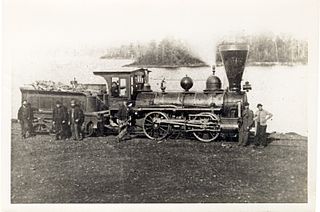
The Cobourg and Peterborough Railway (C&PRy) was one of the first railway lines to be built in Central Ontario, Canada. The line was initially considered in 1831 as a way to bring the products from the burgeoning area around Peterborough to markets on Lake Ontario through the port in the town of Cobourg. Before the railway the only means of travel was by stage coach lines between larger populated areas overland or by boat. A series of problems, including the Upper Canada Rebellion and the Panic of 1837, meant that construction did not begin until 1853, reaching Peterborough in 1854.
Zeidler Architecture Inc. is a national architecture, interior design, urban design, and master planning firm with four Canadian offices located in Toronto, Calgary, Vancouver, and Victoria.
Alene E. Holt was the first female alderman for Peterborough, Ontario, elected in 1959 and the first female mayor, appointed in 1962.
William Blackwell was a Canadian architect active in Peterborough, Ontario, for over 40 years. He was among the first architects to use the Romanesque Revival style in Ontario.
Walter Rolleston Lightfoot Blackwell was a Canadian architect known for his work in Peterborough, Ontario, and a number of Bank of Toronto branches across Ontario. He was the son of William Blackwell and an early partner of Eberhard Zeidler.


















